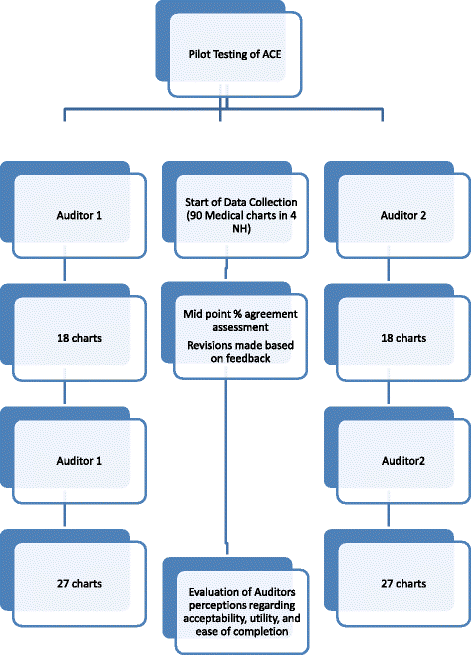Developing and testing a nursing home end -of -life care chart audit tool
- PMID: 29544471
- PMCID: PMC5856383
- DOI: 10.1186/s12904-018-0301-9
Developing and testing a nursing home end -of -life care chart audit tool
Abstract
Background: Nursing home (NH) administrators need tools to measure the effectiveness of care delivered at the end of life so that they have objective data on which to evaluate current practices, and identify areas of resident care in need of improvement.
Methods: A three-phase mixed methods study was used to develop and test an empirically derived chart audit tool aimed at assessing the care delivered along the entire dying trajectory.
Results: The Auditing Care at the End of Life (ACE) instrument contains 27 questions captured across 6 domains, which are indicative of quality end-of-life care for nursing home residents.
Conclusions: By developing a brief chart audit tool that captures best practices derived from expert consensus and the research literature, NH facilities will be equipped with one means for monitoring and assessing the care delivered to dying residents.
Keywords: Audit tool; Focus groups; Nursing home; Palliative care; Quality of care; Tool development; Tool validation.
Conflict of interest statement
Ethics approval and consent to participate
Ethical approval for this study was obtained from the University of Manitoba Education Nursing Research Ethics Board, Winnipeg Manitoba, Canada. Reference number E2013:079.
Consent for publication
Not applicable.
Competing interests
The authors declare that they have no competing interests.
Publisher’s Note
Springer Nature remains neutral with regard to jurisdictional claims in published maps and institutional affiliations.
Similar articles
-
Nursing home physician educational intervention improves end-of-life outcomes.J Palliat Med. 2003 Apr;6(2):205-13. doi: 10.1089/109662103764978452. J Palliat Med. 2003. PMID: 12854937
-
Impact of Symptoms and Care Practices on Nursing Home Residents at the End of Life: A Rating by Front-line Care Providers.J Am Med Dir Assoc. 2016 Feb;17(2):155-61. doi: 10.1016/j.jamda.2015.11.002. Epub 2015 Dec 23. J Am Med Dir Assoc. 2016. PMID: 26706418
-
The last 48 hours of life in long-term care: a focused chart audit.J Am Geriatr Soc. 2002 Mar;50(3):501-6. doi: 10.1046/j.1532-5415.2002.50117.x. J Am Geriatr Soc. 2002. PMID: 11943047
-
Palliative care--a service to improve the dying experience in hospitals and nursing homes.Hawaii Med J. 2002 Jan;61(1):6-9. Hawaii Med J. 2002. PMID: 11868200 Review.
-
Outcome measures in palliative care for advanced cancer patients: a review.J Public Health Med. 1997 Jun;19(2):193-9. doi: 10.1093/oxfordjournals.pubmed.a024608. J Public Health Med. 1997. PMID: 9243435 Review.
Cited by
-
The development of a questionnaire to assess the willingness of Chinese community health workers to implement advance care planning.BMC Palliat Care. 2022 Sep 9;21(1):157. doi: 10.1186/s12904-022-01046-8. BMC Palliat Care. 2022. PMID: 36085142 Free PMC article.
References
-
- Doupe M, Fransoo R, Chateau D, Dik N, Burchill C, Soodeen R, et al. Population aging and the continuum of older adult care in Manitoba. Winnipeg: Manitoba Centre for Health Policy; 2011.
-
- Allison JJ, Wall TC, Spettell CM, et al. The art and science of chart review. Jt Comm J Qual Improv. 2000;26:115–136. - PubMed
MeSH terms
Grants and funding
LinkOut - more resources
Full Text Sources
Other Literature Sources
Medical
Miscellaneous


